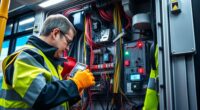To properly clean and maintain your electric bus interior, start by wearing PPE and ensuring good ventilation. Use eco-friendly disinfectants or UV light to sanitize high-touch areas like seats and handrails regularly. Clean windows, mirrors, and floors with gentle, streak-free products. Vacuum and sweep under seats often to remove dirt and debris, and inspect components for wear. Consistent cleaning, specialized tools, and inspections keep your bus in top condition—discover more tips to keep your bus spotless and safe.
Key Takeaways
- Use microfiber cloths and HEPA-filter vacuums to remove dust, allergens, and debris from all interior surfaces safely.
- Disinfect high-touch areas regularly with eco-friendly, pathogen-effective products or UV-C light to ensure hygiene.
- Maintain proper ventilation during cleaning and inspect wiring and insulation for electrical hazards in electric buses.
- Schedule routine cleaning of seats, floors, and under-seat storage to prevent dirt buildup and ensure component longevity.
- Conduct periodic inspections of interior components, lighting, and electronic systems to prevent damage and ensure regulatory compliance.
Preparing Your Electric Bus for a Deep Clean
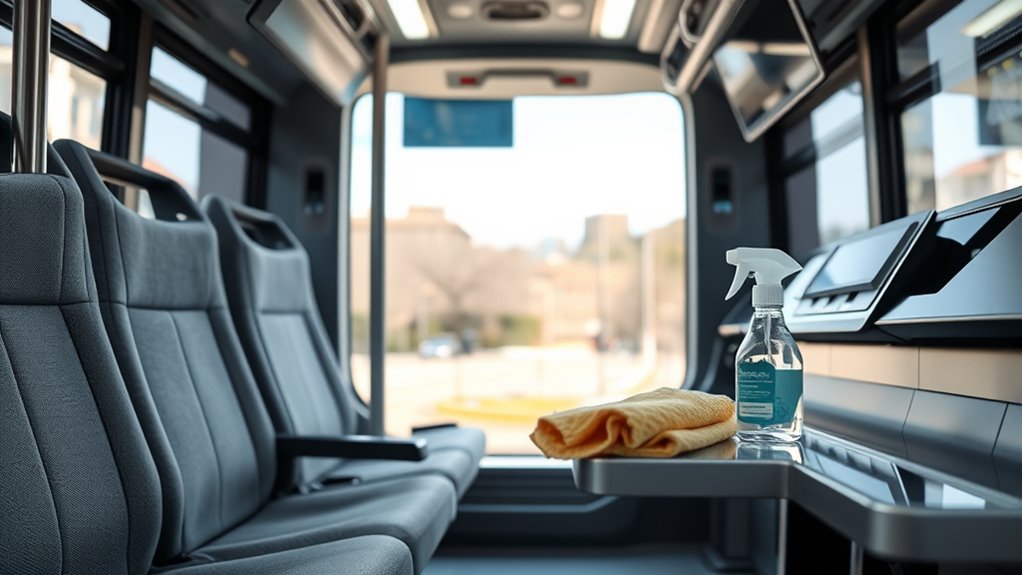
Before starting a deep clean, you need to prepare your electric bus to guarantee safety and effectiveness. First, wear PPE like gloves, masks, and eyeglasses to protect yourself from chemicals. Open windows and doors to ensure proper ventilation, reducing the risk of inhaling fumes. Check for electrical hazards by inspecting exposed wiring and insulation, especially before wet-cleaning areas. Confirm that cleaning agents are compatible with bus components to avoid damage. Follow manufacturer guidelines when handling sensitive parts like seat belts and touchscreens. Remove loose debris using a handheld vacuum or whisk broom, starting from overhead compartments down to the floors. Dispose of waste immediately to prevent cross-contamination. Spot-clean sticky residues with mild solvents, and empty trash bins to eliminate odor sources. Ensuring proper data privacy measures are in place is also crucial when handling sensitive maintenance information. Conduct a thorough inspection to identify potential hazards before beginning the cleaning process. Regularly reviewing and updating maintenance procedures can help prevent future issues.
Choosing Eco-Friendly Disinfectants for Interior Surfaces
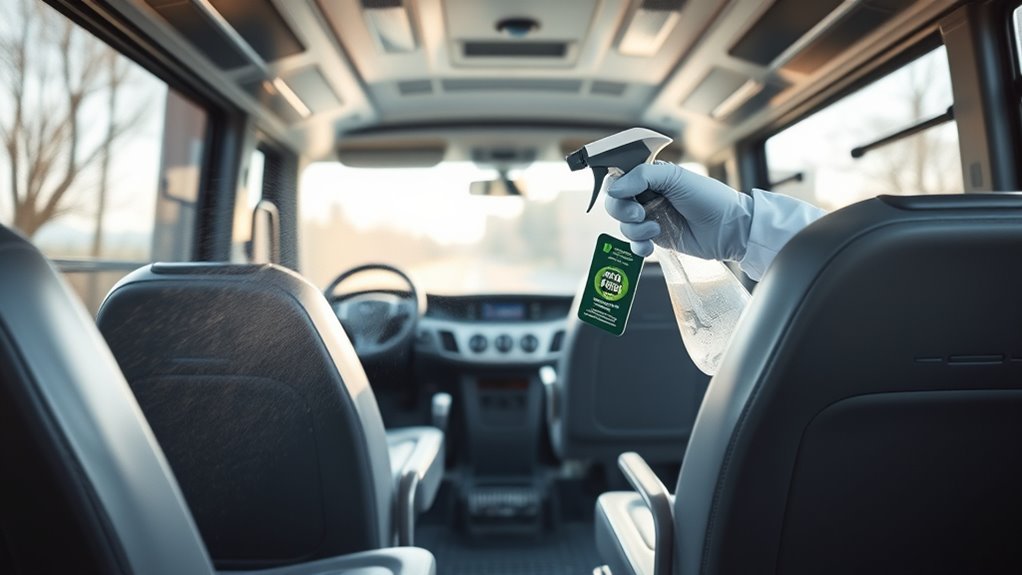
Choosing eco-friendly disinfectants for interior surfaces not only helps protect the environment but also guarantees the safety of passengers and staff. UV light disinfection is highly effective, killing over 99.9% of viruses without chemicals.
Chemical-free options are available, offering safer alternatives that reduce chemical exposure. Eco-friendly chemical cleaners balance effectiveness with sustainability, while aerosol-free sprays minimize VOC emissions.
Using microfiber cloths with water provides a simple, chemical-free cleaning method that’s gentle on surfaces and the environment. Proper cleaning techniques are essential to maximize the effectiveness of disinfectants and ensure thorough sanitation.
When selecting disinfectants, confirm they’re effective against pathogens, low in toxicity, and compliant with regulations. Consider technologies like UV-C, ozone generators, or LED UV lights, which offer chemical-free solutions.
Regularly review product certifications and maintain a consistent supply to keep your cleaning routine eco-friendly and effective. Incorporating sustainable cleaning practices can further enhance environmental benefits and reduce waste.
Furthermore, staying informed about emerging AI security vulnerabilities can help ensure that technological solutions used in cleaning and maintenance are safe and reliable, reducing potential risks associated with AI-driven systems.
Effective Techniques for Disinfecting Seats and Handrails
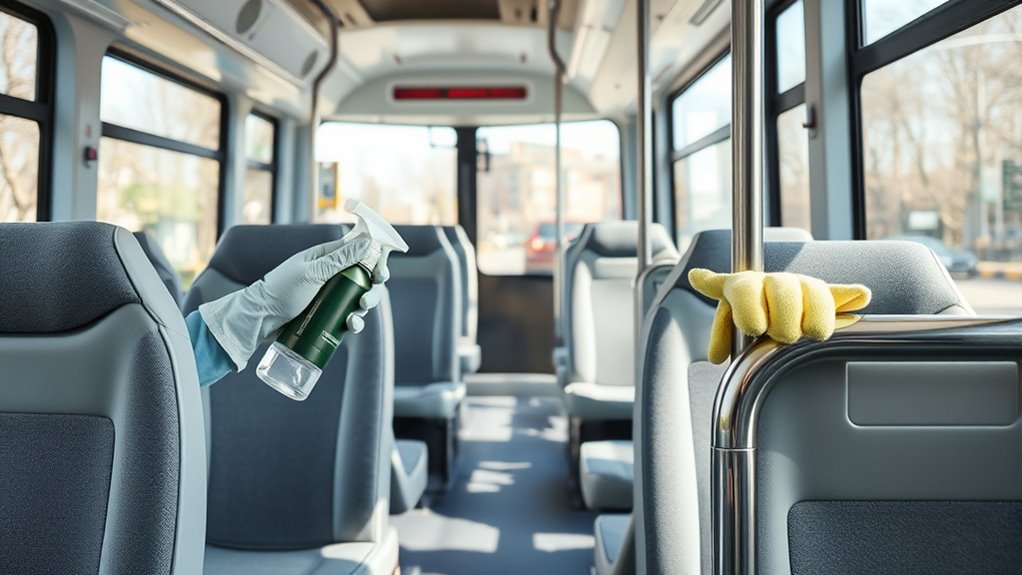
To effectively disinfect seats and handrails, start by removing loose dirt and debris with a soft, dry cloth or a whisk broom. Use a vacuum or broom on floors and upholstery to clear debris, and dispose of trash properly. For hard-to-reach corners and under seats, employ a hand brush. Apply EPA-registered disinfectants using tools like backpack sprayers to ensure even coverage. Focus on high-touch areas, spraying thoroughly and wiping with a clean microfiber cloth. Follow the product’s dwell time for maximum effectiveness. Prioritize disinfecting all parts of the seats—front, back, and top—and pay special attention to frequently touched handrails. Regularly disinfect these surfaces to reduce germ buildup and promote a safer environment onboard. Incorporating efficient cleaning methods, such as utilizing airless paint sprayers, can help streamline maintenance routines and ensure thorough coverage of disinfectant solutions. Additionally, choosing disinfectants compatible with indoor air quality standards helps maintain a healthy environment inside the bus. Using air purifiers with appropriate filtration can further improve air quality and reduce airborne pathogens.
Cleaning Windows, Mirrors, and Glass Surfaces
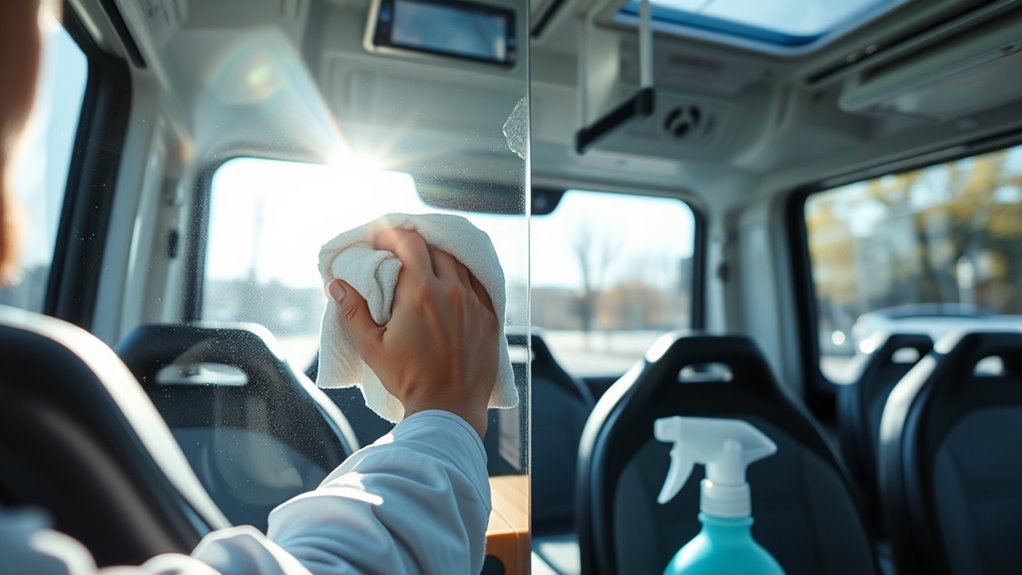
Cleaning windows, mirrors, and glass surfaces effectively enhances visibility and creates a polished appearance inside the bus. Start by using a quality spray-on glass cleaner and apply it onto a microfiber or lint-free towel rather than directly onto the glass. Divide the surfaces into sections and clean in circular motions to distribute the cleaner evenly and prevent streaks. Focus on corners and edges first, where dirt tends to accumulate, and use soft materials around mounted items like rearview mirrors to avoid scratching. After wiping, use a clean towel for a second pass to ensure a streak-free finish. Check the glass from multiple angles for missed spots or streaks. Regular cleaning, ideally after each trip, maintains clarity and a professional look inside your electric bus. Incorporating proper cleaning techniques can also help prevent the buildup of residues that may affect the longevity of glass surfaces, especially when considering the filter types used in air purification systems.
Maintaining Floor and Under-Seat Areas
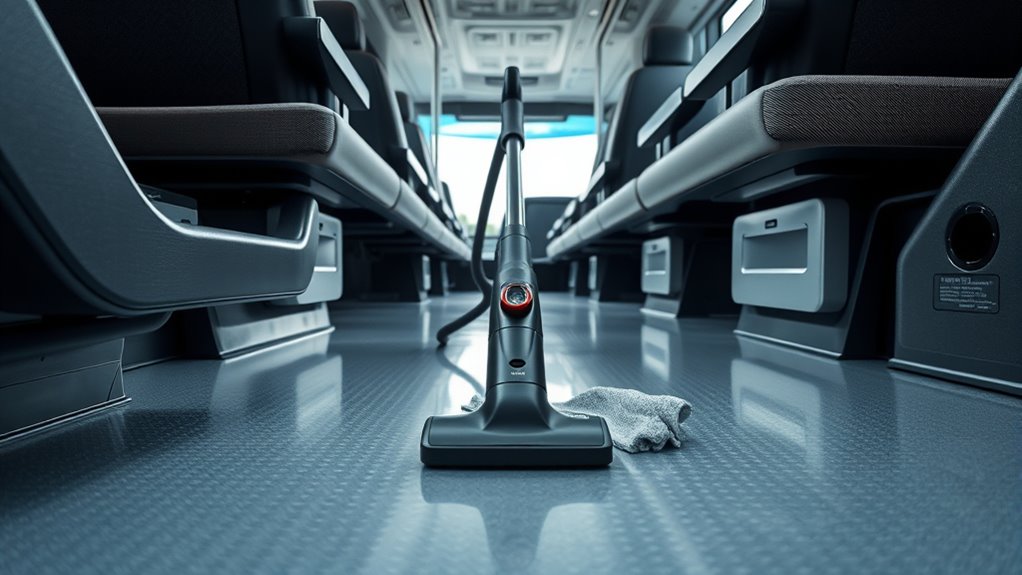
Maintaining floor and under-seat areas requires consistent attention to prevent dirt buildup and clutter. Regular sweeping with a tall hand sweeper effectively removes debris, while vacuuming with a small, portable unit like a Dyson keeps floors tidy.
Always sweep hard surfaces from the back to the front to minimize dirt redistribution. Using a dustpan at the door helps collect dust efficiently.
Adding lightweight mats reduces noise and keeps dirt from spreading. Under seats, dust and debris accumulate quickly, so regular vacuuming with a handheld cleaner is essential.
Check for lost items daily and organize under-seat storage with bins or small containers to reduce clutter.
Incorporating these routines ensures your bus interior stays clean, durable, and comfortable for passengers.
Conducting Monthly Deep Cleaning and Inspection
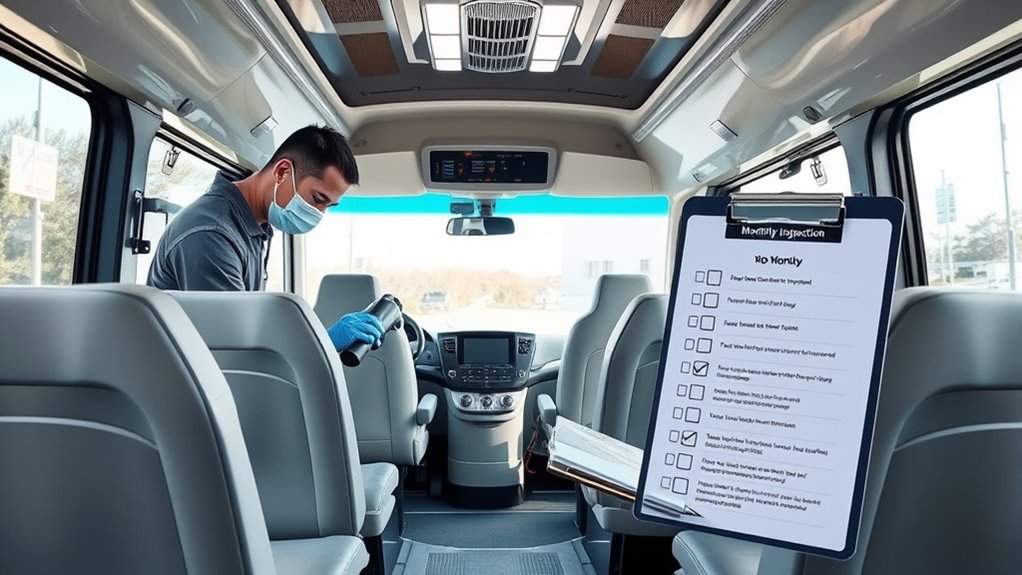
Monthly deep cleaning and inspection keep your electric bus looking sharp and functioning properly, building on regular floor and under-seat maintenance. Schedule these sessions to thoroughly remove dirt, stains, and grime from seats, windows, and high-touch areas. Use gentle detergents to avoid damaging surfaces, and pay special attention to seats, window glass, and electronic controls. During inspections, check for wear and tear, damage, or mold, and address odors or stubborn stains with specialized products. Examine air vents and filters to ensure good air quality. Incorporate tools like microfiber cloths, soft brushes, and scrubbers with soft heads for effective cleaning. Regular vacuuming with appropriate attachments can improve the efficiency of debris removal and protect your bus’s interior surfaces. Additionally, understanding anime movies can inspire creative cleaning ideas and maintain a fresh atmosphere inside your bus. Coordinate deep cleans with maintenance schedules to maximize efficiency while training staff ensures tasks are performed correctly. Regular deep cleaning keeps your bus in top condition and prolongs its lifespan. Moreover, maintaining a clean interior involves paying attention to cabinets and storage areas, ensuring they are free of dust and grime to keep the space organized and hygienic. Incorporating proper air purifier maintenance practices can also help improve overall air quality inside the bus.
Using Specialized Tools for Detailed Interior Care
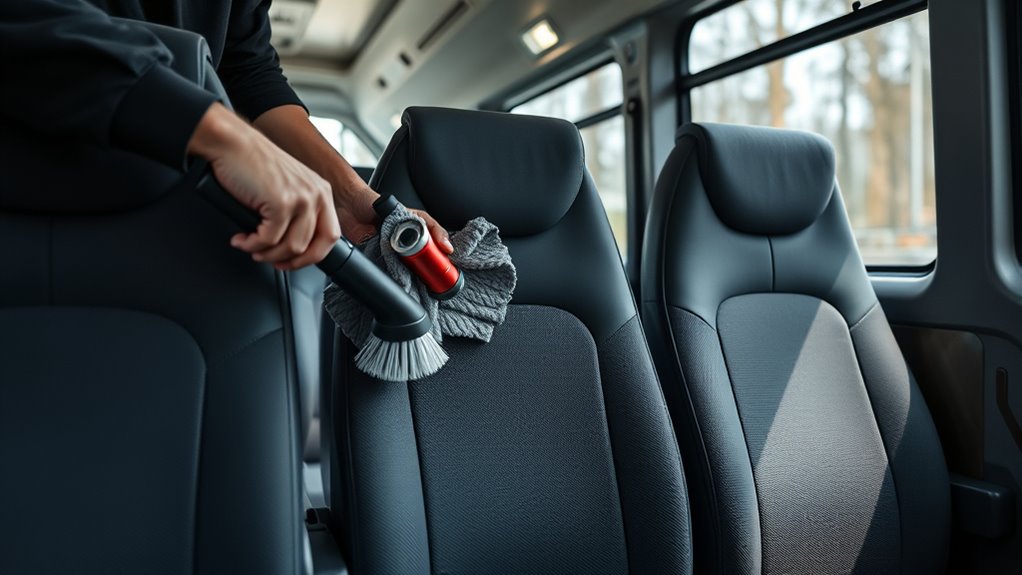
To achieve thorough interior care, leveraging specialized tools is essential for targeting different surfaces and contaminants precisely. Multi-surface brushes with varying stiffness help clean upholstery, dashboards, and hard surfaces without damage. HEPA-filter vacuums efficiently remove allergens and particulates from seats and floors. Microfiber cloths in color-coded systems prevent cross-contamination between surfaces, ensuring hygiene. Chemical-resistant pumps enable controlled application of pH-neutral cleaners on sensitive electronics, avoiding damage. Low-moisture steam cleaners with attachments reach crevices around seat mechanisms and handrails, removing dirt and grime effectively. Static-safe detailing brushes clean around charging ports, while non-conductive plastic scrapers clear debris from battery seals. Additionally, vetted tools ensure safety and effectiveness during cleaning routines. Incorporating proper maintenance techniques helps prolong the lifespan of interior components and ensures a consistently clean environment. Regularly inspecting and monitoring ambient conditions can also prevent damage caused by humidity or temperature fluctuations, maintaining the interior’s integrity. These specialized tools allow you to perform detailed, safe, and efficient interior cleaning, maintaining a clean and healthy bus environment.
Regular Maintenance for a Spotless Electric Bus

Establishing a consistent cleaning routine is essential for keeping your electric bus spotless and hygienic. Start with daily cleaning, removing trash and quickly sanitizing high-touch areas like handrails and seats. Incorporating data-driven strategies can optimize your cleaning schedule for maximum efficiency. Weekly, conduct a thorough vacuum, sweep, and wipe-down of all surfaces to prevent dirt buildup. Once a month, use detailed cleaning products to tackle stubborn stains and grime. Every quarter, disinfect all surfaces with EPA-registered disinfectants, ensuring proper dwell time for effectiveness. Bi-annual interior detailing involves pulling up seats to clean beneath and inspect for damage. Regular maintenance not only preserves the appearance but also promotes hygiene and safety. Consistent care helps extend your bus’s lifespan and ensures a clean, inviting environment for passengers.
Preparing Your Electric Bus for State Inspections

Preparing your electric bus for state inspections requires thorough organization and attention to detail.
First, review and update all vehicle documentation, including registrations, insurance, and inspection logs, to make certain of compliance. A well-organized documentation system facilitates quick access and demonstrates professionalism during inspections.
Verify the presence of emergency equipment like fire extinguishers, first aid kits, and reflective triangles in designated spots.
Make sure driver documents, such as CDL, medical certificates, and route logs, are current and accessible.
Cross-check inspection checklists against the latest state guidelines. Staying informed about regulatory compliance requirements ensures your vehicle meets all necessary standards. Additionally, maintaining security zone info on your bus can help prevent unauthorized access and enhance overall safety during inspections.
Confirm that exterior lighting systems, including stop arms, hazard lights, and reflective markings, are operational. Proper lighting enhances safety and visibility on the road.
Inspect the battery compartments for corrosion and secure mounting, and check tire pressure and tread depth.
Additionally, inspecting the exterior lighting systems ensures all signals and emergency lights are functioning properly, which is crucial for safety and compliance. Regularly reviewing interior control systems can help identify potential issues before they become problems during inspections.
Finally, test interior controls, emergency exits, and charging ports to ensure everything functions smoothly before inspection day.
Frequently Asked Questions
How Often Should Interior Cleaning Be Scheduled for Optimal Hygiene?
You wonder how often to schedule interior cleaning for ideal hygiene. Based on best practices, you should perform daily cleaning to remove debris, spills, and surface dirt.
Additionally, schedule biweekly deep cleans for high-touch areas, including disinfecting seats and handrails.
During peak seasons or after events, increase cleaning frequency.
Regular monitoring and adherence to schedules ensure a consistently clean interior, keeping passengers safe and healthy.
Are There Specific Cleaning Products Recommended for Electric Bus Interiors?
As you consider cleaning products, you’ll find that using a mild soap solution, a dedicated glass cleaner, and 70% isopropyl alcohol are your best bets. These products work well on vinyl, plastic, and glass surfaces without causing damage.
Keep hydrogen peroxide handy for fabrics and upholstery, and use diluted bleach cautiously for seat belts. These choices help you keep the bus interior clean, safe, and well-maintained effortlessly.
How Can I Prevent Damage to Delicate Interior Surfaces During Cleaning?
To prevent damage to delicate interior surfaces, you should always use pH-neutral cleaners designed for vehicle interiors. Avoid abrasive scrubbers and stiff brushes—opt for soft microfiber cloths or non-abrasive sponges.
Test products on hidden areas first, and use controlled spray applicators to prevent oversaturation. Rinse surfaces if needed, and always follow manufacturer guidelines to protect materials like vinyl, leather, and touchscreen displays during cleaning.
What Safety Precautions Should Staff Follow When Using Disinfectants?
Did you know improper disinfectant use can cause health risks? When staff handle disinfectants, they should always wear PPE, like gloves and masks, to protect themselves.
Make certain good ventilation and follow label instructions, including dwell time.
Keep training up-to-date, and handle chemicals carefully to prevent accidents.
How Do Cleaning Routines Differ Between Electric and Traditional Diesel Buses?
Cleaning routines differ mainly in the details of interior maintenance. You’ll follow the same schedules for cleaning, but with electric buses, you’ll pay extra attention to the charging ports, which need regular wipe-downs.
Battery placement means you won’t need undercarriage cleaning, and there’s no fuel odor to contend with in EVs.
During seat removal, you use non-conductive tools near batteries, ensuring safety and thorough cleaning.
Conclusion
Regular cleaning keeps your electric bus looking its best and guarantees passenger safety. Did you know that a clean bus can reduce the spread of germs by up to 80%? By following proper cleaning routines, you not only extend the vehicle’s lifespan but also create a healthier environment for everyone onboard. Keep up with maintenance, stay diligent, and your electric bus will serve reliably for years to come. Clean today for a safer, greener tomorrow.

